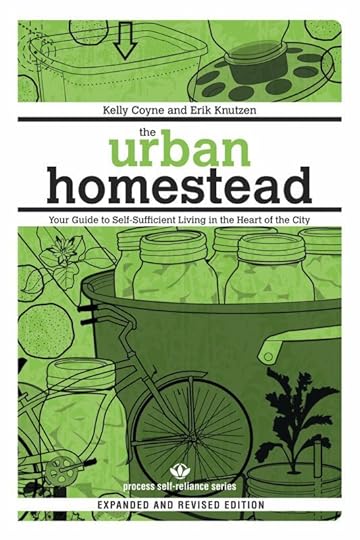How to Build an Urban Homestead
 The Urban Homestead: Your Guide to Self-Sufficient Living in the Heart of the City
The Urban Homestead: Your Guide to Self-Sufficient Living in the Heart of the City
by Kelly Coynce and Eric Knutzen
Process (2010)
Book Review
This book sees three possible options for the future of industrialized society:
More of the same: a ruling elite with access to organic food and solar panels, with ordinary people eating heavily processed foods and being defined as “consumers” rather than citizens.An apocalypse – driven mainly by resource shortages, civilization collapsesA shift in consciousness – a new urban agriculture arises, with people relying on their neighbors and community building rather than big tech.The Urban Homestead offers an extremely comprehensive survival guide for all three of these options. The authors point out how citizens of Shanghai already produce 85% of their veggies within the city and how Cuban city dwellers produce half the fresh fruits and vegetables they consume.
Meanwhile in the West, industrialized farming produces food that is flavorless and nutrition-less (thanks to farming practices that destroy topsoil organisms essential to the production of health plants).
This survival guide provides very comprehensive tips for growing your own fruits and veggies, following a “permaculture* approach; for “guerilla gardening” (feoqinf food gardens on public and abandoned property”; for urban foraging of edible and wild foods; and for raising chickens, ducks, rabbits, pigeons and bees for food production.
The book also has detailed chapters on various food preservation techniques (including fermenting, canning, drying, jellies and jams and yogurt and cheese); DIY cleaning products; DIY water harvesting; growing food in an apartment; DIY energy efficiency schemes; and DIY energy options, including solar ovens and rocket stoves.**
*The permaculture approach emphasizes polycropping (the best technique for minimizing pests): no-till planting (to minimize damage to soil organisms); perennial crops (to minimize soil disruption), eg fruit and nut trees, berry bushes and semi-perennial vegetables such as kale, broccoli, collards and lettuces; and companion planting; and other spray-free pest control techniques.
**Rockets stoves, which are surprisingly easily to build, burn sticks and twigs as fuel and are twice as efficient as conventional wood stoves.
The Most Revolutionary Act
- Stuart Jeanne Bramhall's profile
- 11 followers



